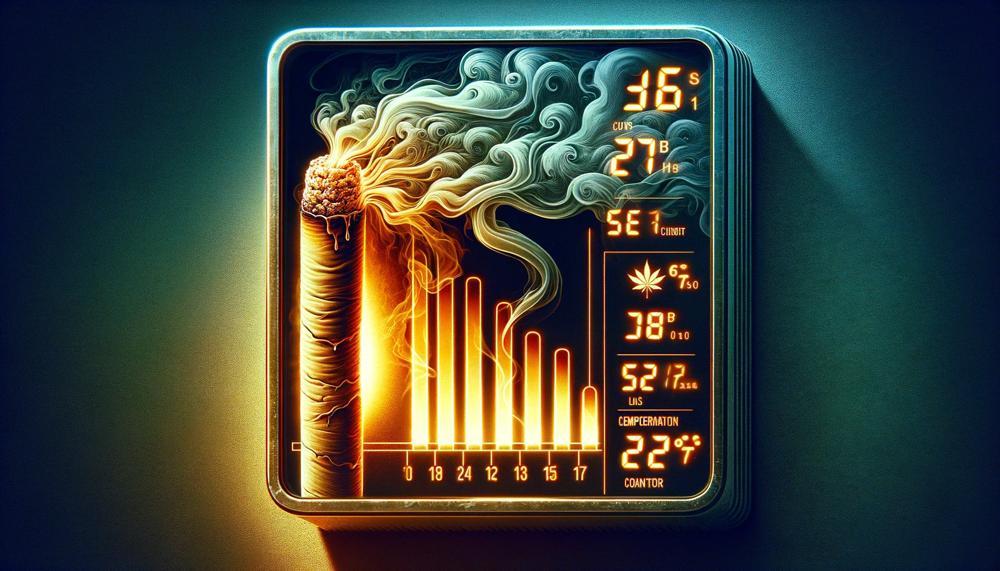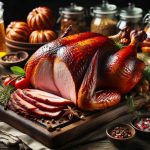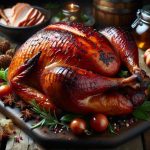Tired of playing a constant game of temperature roulette with your smoker? Whether you’re a seasoned pro or just starting out, maintaining a consistent temperature while smoking can be a challenge.
We’re here to uncover the reasons behind these fluctuations and provide you with some helpful tips for achieving that perfect cook every time.
So, why does my smoker temp fluctuate so much?
Temperature fluctuations in your smoker can be due to several factors:
- Pellet Quality & Sawdust: Low-quality or old pellets are the #1 cause of temperature management issues.
- Air Circulation: Fire needs oxygen, and if there’s not enough, the fire won’t stay lit.
- Opening the Lid too Often: Repeated opening and closing of the lid too often can cause temperature issues.
- Incorrect Startup & Shutdown: Improper startup and shutdown will often lead to temperature issues during your cook.
- Changing the Grill’s Temperature Often: Frequently changing the set temperature can cause fluctuations.
- Using Foil as a Drip Liner: If the foil is not flush against the drip tray, it can disrupt air circulation through the barrel.
- Damaged or Missing Drip Tray or Heat Baffle: These can affect the grill’s ability to maintain an average temperature.
- Firepot Not Being Installed Correctly: This can lead to temperature issues.
Contents [show]
Why Does My Smoker Temp Keep Dropping?
When it comes to smoking meat, controlling the temperature is crucial for achieving the perfect smoky flavor and tender texture. However, it is not uncommon for smokers to experience fluctuations in temperature, which can be frustrating, especially for beginners.
There are several factors that can contribute to a smoker’s temperature dropping, and understanding them is essential for maintaining consistent temperature levels and producing delicious smoked meat every time.
Air Leaks: The Culprit Behind Temperature Fluctuations
One of the main culprits of temperature drops in smokers is air leaks. These leaks can occur at any point along the smoker, such as the doors, vents, or even around the fuel source. To prevent or fix this issue, regularly check your smoker for any air leaks and seal them using high-temperature silicone or gasket tape.
This simple step can make a significant difference in maintaining consistent temperatures.
Choosing the Right Fuel for Consistent Temperatures
The type of fuel you use in your smoker can also affect temperature fluctuations.
It is essential to use high-quality fuel, such as hardwood or charcoal, that has been preheated before adding it to your smoker. This will ensure a more steady and consistent heat source.
Location Matters: Placing Your Smoker in the Perfect Spot
Where you place your smoker can also impact its temperature.
It is best to keep your smoker in a sheltered area away from wind and direct sunlight. Additionally, make sure it is on a level surface to avoid any changes in heat distribution.
Don’t Run Out of Fuel: Monitoring Levels is Key
Running out of fuel mid-smoke can be a nightmare for any pitmaster.
To prevent this from happening, always monitor your fuel levels closely. It is recommended to have extra fuel on hand to avoid any interruptions during the smoking process.
Understanding the Working Principles of a Smoker
To maintain consistent temperatures in your smoker, it is crucial to understand how it works.
Every smoker is different, and understanding its specific working principles will help you troubleshoot any temperature fluctuations and make necessary adjustments.
Weather Conditions: Another Factor to Consider
Weather conditions, such as wind and rain, can also affect your smoker’s temperature.
It is important to take these factors into account when choosing the location for your smoker and adjusting accordingly during the smoking process.
Keep Your Smoker Clean for Optimal Performance
A dirty smoker can also contribute to temperature fluctuations. Make sure to regularly clean your smoker, including the grates, vents, and firebox, to ensure optimal performance.
Adjusting for Different Cuts of Meat
Different cuts of meat require different smoking temperatures for optimal results.
It is essential to adjust your smoker’s temperature accordingly to achieve the best flavor and texture for the specific cut you are smoking.
Why Does My Smoker Keep Going Out?
There are several common factors that can contribute to a smoker repeatedly going out, including subpar fuel quality, inadequate airflow, insufficient insulation, frequent opening of the smoker lid, and lack of maintenance and cleaning.
To prevent this issue from occurring, it is essential to use high-quality fuel, ensure proper ventilation and insulation, limit the number of times the lid is opened, and regularly clean and maintain the smoker.
Many smokers struggle with keeping their smoker lit, often resorting to frequent refueling or even abandoning their cooking entirely. However, by following a few simple tips, you can keep your smoker burning consistently and efficiently.
The first step in preventing your smoker from going out is to ensure that you are using high-quality fuel. Poor quality fuel can lead to inconsistent burning and may even cause your smoker to go out altogether. Investing in high-quality wood chips or pellets will not only improve the overall taste of your food but also prevent any potential issues with lighting and keeping your smoker lit.
Another key factor in maintaining a consistent burn in your smoker is proper airflow and insulation. Make sure that your smoker is well ventilated and insulated to avoid any oxygen deficiencies that could cause your smoker to go out. Additionally, reducing the number of times you open the lid of your smoker during cooking can help maintain a consistent temperature and prevent any heat loss.
Lastly, regular cleaning and maintenance of your smoker are crucial in ensuring it functions properly. A buildup of ash or debris can hinder proper airflow and lead to inconsistent burning. By regularly cleaning and maintaining your smoker, you can prevent any potential issues and keep it burning efficiently.
What To Do If Your Smoker Temp Keeps Dropping?
Maintaining a steady cooking temperature and preventing your smoker’s temperature from dropping is crucial for producing the perfect BBQ.
This can be achieved by ensuring proper airflow, using the right type of wood or charcoal, strategic placement of the smoker, and regular cleaning. Here are some specific steps you can take to prevent your smoker temperature from dropping:
- Adjust the vents and dampers: The intake and exhaust dampers are vital for controlling the airflow in your smoker. Make sure they are properly adjusted to allow the right amount of oxygen to enter and circulate the smoker. Too much oxygen can cause a rise in temperature, while too little can result in a drop.
- Select the appropriate type of wood or charcoal: Different types of wood or charcoal burn at different rates and produce varying levels of heat. It is crucial to choose the right type based on your desired cooking temperature and time. For instance, larger pieces of wood or charcoal burn longer and produce more heat, ideal for maintaining a low and slow cooking temperature.
- Strategically position the smoker: Wind can affect the airflow inside your smoker, leading to temperature fluctuations. Place your smoker in an area sheltered from strong winds to avoid this issue. Also, consider rotating it if one side has more exposure to wind to minimize its impact on the airflow.
- Use a water pan: To stabilize heat and prevent dryness in food, place a water pan between the heat source and cooking chamber. It acts as a barrier and regulates the temperature, resulting in more consistent heat levels.
- Avoid frequent chamber openings: Each time you open the smoker’s chamber, you release heat and smoke, causing a drop in temperature. To maintain consistent heat levels, try minimizing chamber openings as much as possible.
- Use a dedicated thermometer: The built-in thermometers on smokers may not always provide accurate readings. To ensure better precision and monitoring of temperatures, it is recommended to use a dedicated thermometer.
- Adjust vents slowly: When making changes to the vents and dampers, do it gradually. Sudden adjustments can lead to drastic temperature fluctuations, potentially ruining your BBQ.
- Aim for a lower cooking temperature range: If you need to leave your smoker unattended, aim for a lower cooking temperature range. This allows for longer cook times and gives you more time to react if any temperature fluctuations occur.
By following these steps, you can maintain a steady cooking temperature and prevent your smoker’s temperature from dropping, resulting in the perfect BBQ every time.
What Not To Do If Smoker Temp Keeps Dropping?
| WHAT NOT TO DO IF SMOKER TEMP KEEPS DROPPING? | CONSEQUENCES OF MAKING THESE MISTAKES | HOW TO AVOID THEM |
|---|---|---|
| Failure to start with a clean smoker | Accumulated buildup can affect both the temperature and flavor of your meat | Always clean your smoker with a wire brush before each use and make sure to empty the ash pan. |
| Not preheating the smoker | Inconsistent cooking results due to fluctuating temperatures | Preheat your smoker before adding your meat to ensure an even distribution of heat. |
| Using the wrong type of wood | Inconsistent temperature control due to varying burning rates of different woods | Stick to hardwoods like oak or hickory and avoid using wet or green wood. |
| Frequent opening of the smoker | Temperature fluctuations every time the smoker is opened, leading to unevenly cooked meat | Avoid opening your smoker unnecessarily and keep it closed as much as possible. |
| No thermometer usage | Inaccurate temperature readings can result in overcooked or undercooked meats | Invest in a separate thermometer and place it directly into the meat for accurate readings. |

Ensuring that you avoid these common mistakes will help you maintain a consistent temperature in your smoker throughout the entire cooking process, resulting in perfectly cooked meats.
How Do You Stabilize Smoker Temperatures?
There are various factors that can disrupt the stability of smoker temperatures, including external conditions, pellet quality, ash buildup, and heating element inefficiency. These fluctuations can lead to unevenly cooked meats and other frustrating issues. To achieve a stable temperature, there are several strategies that can be implemented.
Firstly, preheating the smoker is essential in ensuring a consistent temperature throughout the cooking process. Additionally, positioning the smoker against a windbreak can help prevent external elements from affecting the temperature. Regularly cleaning the smoker is also crucial, as ash buildup can interfere with proper heat distribution.
Another effective method is to use thermal blankets or wraps to insulate the smoker and maintain a steady temperature. Adjusting vents can also help regulate the airflow and temperature inside the smoker. For more precise control, digital temperature controllers can be utilized.
To make informed adjustments, it is important to keep a log of temperature patterns and cooking outcomes. This allows for a better understanding of how different factors may be impacting the temperature and cooking results.
By implementing these strategies and keeping track of temperature patterns, one can achieve a stable temperature in their smoker and avoid common issues such as unevenly cooked meats.
Should You Start Adding More Fuel?
When it comes to smoking meats, adding more fuel to your smoker can have a significant impact on the temperature. However, this should be done strategically, taking into account the type of smoker, cooking method, and external factors like wind and humidity. The amount of fuel used in a smoker can vary greatly depending on these factors.
Generally, adding more fuel means increasing the temperature as it provides more oxygen for combustion. But keep in mind that the effect may not always be immediate and can depend on the size and type of fuel being added.
Considering the type of fuel being used is crucial when adding more to your smoker. For example, charcoal briquettes burn at a consistent temperature for a longer period compared to wood chips or chunks, which can produce quick bursts of heat. This means that adding more charcoal briquettes may result in a more gradual increase in temperature compared to adding wood chips or chunks.
Increasing the amount of fuel also means increasing the level of oxygen in the smoker. As mentioned earlier, regulating temperature in a smoker requires adjusting intake and exhaust dampers. Therefore, when adding more fuel, it is important to also adjust the dampers accordingly to maintain a stable temperature. Closing vents too quickly after adding more fuel can cause smoke to fill the chamber and potentially ruin your food.
Additionally, constantly adding more fuel throughout the smoking process can cause fluctuations in temperature. To avoid this, it is important to monitor your smoker’s patterns and understand how much fuel is needed for your desired cooking time and temperature. Some smokers may require more frequent fuel additions, while others may be able to maintain a consistent temperature with fewer additions.
How Much Fuel Is Enough?
Typically, the recommended amount of charcoal or wood chunks to fill your smoker’s fuel chamber is up to 2/3rd capacity. However, external factors such as the type of smoker, the type of fuel being used, and the surrounding conditions can all impact the required amount.
Therefore, it is crucial to closely monitor and adjust as necessary for consistent results.
How Much Fuel Is Enough?
When it comes to smoking meats, the type and amount of fuel used play a significant role in achieving the perfect flavor and tenderness. While there are general guidelines for how much fuel to use in a smoker, it ultimately depends on various factors.
Firstly, the type of smoker you have will greatly impact the amount of fuel needed. For example, a large offset smoker will require more fuel compared to a smaller electric smoker. Additionally, the type of fuel being used, whether it be charcoal or wood chunks, will also affect the quantity needed.
However, it’s not just about the size and type of smoker. External conditions such as temperature and humidity can also play a role in how much fuel is needed. A colder environment may require more fuel to maintain a consistent heat, while a hot and humid day may result in less fuel being needed.
It is crucial to closely monitor your smoker while in use and make adjustments accordingly. If the temperature starts to drop, adding more fuel may be necessary. On the other hand, if the temperature is too high, removing some fuel can help regulate it.
Should You Open the Vents?
Yes, you should open the vents on your smoker to control temperature fluctuations.
Ensuring a steady temperature is crucial for successful smoking. By opening the vents, you allow for better airflow, which helps regulate the internal temperature of the smoker. This is especially important when using charcoal smokers, as charcoal burns hotter than wood and can cause significant temperature fluctuations if not managed properly.
The intake and exhaust vents play a crucial role in controlling the temperature inside a smoker. The intake vent regulates the amount of oxygen that enters the smoker, while the exhaust vent allows for the release of smoke and heat. By adjusting these vents, you can control the amount of oxygen and smoke inside the smoker, thus controlling the temperature.
For optimal results, it is recommended to fully open both vents until the desired temperature of 225°F (107°C) is reached. Once you have achieved this temperature, you can then adjust the vents to maintain it. If the temperature starts to drop, open the intake vent to allow more oxygen and fuel to burn, increasing the heat.
On the other hand, if the temperature starts to rise, partially close the intake vent to limit oxygen intake and reduce heat.
Keep in mind that frequently opening the chamber can cause significant heat loss and disrupt temperature control. So it’s best to avoid opening it unless necessary.
Smoker Temp Drops When Meat is Added
It is no secret that maintaining a steady temperature is key to achieving perfectly cooked meat. This is a known fact that is important for getting perfectly cooked meat. However, a lot of things can change the temperature of your smoker, making it hard to keep it the same. The type and thickness of the meat is one factor. For example, larger cuts of meat will require more time to cook, so you’ll need to adjust the temperature and cooking time accordingly.
The temperature of the meat inside before putting it in the smoker is another thing to think about. The meat may cause the smoker’s temperature to drop a lot if it is too cold. It will also take longer to cook. However, if the meat is too warm, it may cook faster than planned, resulting in overdone or even burned meat.
In addition to weather, moisture levels also influence changes. The more water there is in the meat, the more heat it will absorb from the grill. This could lead to a drop in temperature, especially if you are making a lot of meat that is very moist.
The type and style of your smoker can also affect how stable the temperature is. For example, some smokers are better at keeping the temperature stable than others because they have better insulation. Also, opening the smoker door too much can allow heat to escape, causing the temperature to change.
Conclusion
In conclusion, maintaining a consistent temperature while smoking is no easy feat. Pitmasters often face the challenge of fluctuating temperatures, which can greatly impact the end result of their smoked meats.
However, with a deeper understanding of the contributing factors and effective strategies in place, achieving that perfect cook becomes much more attainable.
From proper maintenance of your smoker to choosing the right fuel and controlling external elements, there are several steps you can take to stabilize temperatures and ensure a successful smoke every time.
Don’t let those pesky temperature fluctuations discourage you – they can be easily managed with the right knowledge and techniques. By avoiding common mistakes and implementing these tips, you’ll be able to bid farewell to playing a constant game of temperature roulette and say hello to perfectly smoked meats with ease.
Remember, a clean, well-insulated, and strategically placed smoker is key to achieving consistent results. So don’t forget to prioritize these factors when preparing for your next smoke session.






